
|   |

|   |
Nitya Nritya: A feast of dance - Usha RK e-mail: simplyushark@gmail.com Photos courtesy: Nupura September 19, 2013 The three day Nitya Nritya dance festival took place in Bangalore from Sept 14 to 16, 2013 at various venues. The festival was inaugurated by celebrated dancer from Delhi Geeta Chandran at the Bharatiya Vidya Bhavan on Sept 14, and this kicked off the morning session on discussions and sharings. Geeta stunned the dance audiences with her immaculate rendition of MS Subbulakshmi’s favourite “Maitrim Bhajata” to mark the inauguration on note of peace, friendship and harmony. It is most commonly felt that morning sessions are boring and too much of knowledge is imparted, thus making them heavy for the art lover’s palette. Invariably only dancers, gurus, students etc attend them making the numbers meagre and few. This time Lalitha Srinivasan, the director of Nitya Nritya, had a solo dancer present for an hour after the lectures / sharings got over. This ensured a wee bit of an audience; at least the dancer’s fans and students came. Day 1: Morning 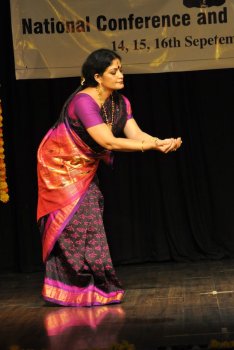 Geeta Chandran Geeta Chandran shared and spoke about her journey in dance, her training, her understanding of music and its primary importance in aspects of dance, specially the varnam, and of course her flights into collaborations and contemporary thoughts and ideas incorporated into her performances keeping the guide lines of Bharatanatyam intact and with no compromise. 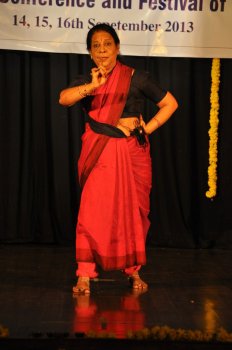 Nandini Ramani Nandini Ramani followed sharing Balasaraswati’s teachings, her philosophy in teaching, the methodology in choreography and how music in this style happens with complete spontaneity. The concept of spirituality was intrinsic to Bala’s dance. 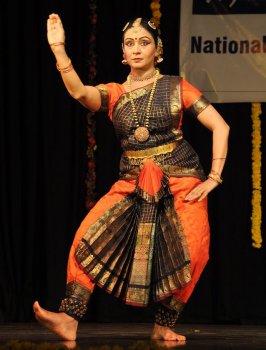
Poornima Ashok
A short Bharatanatyam recital by Poornima Ashok ensued. Poornima is a Bangalore based dancer and has been performing onstage for nearly 28 years. Her gurus include Radha Sridhar and Dhananjayans. Poornima began her performance with the Ardhanarishwara concept based on Adi Shankara’s ‘Champeya gauraiya.’ From the word go, Poornima struck a neat balance presenting the Yin/Yang attributes. The synthesis of Purusha and Prakruthi were exhibited adeptly. It is her angashuddham and dignified approach to dance that catch the eye. A Purandara dasa pada choreographed in the format of a varnam, that was gifted to dancers in Bangalore as part of workshop by Dr. Padma Subrahmanyam was the mainstay of Poornima’s performance. The jathis were composed by Guru Kiran Subramaniam and Poornima made some adaptations to suit her delineation. The pada “hidako bida bedi” in raga Kalyani is a favourite amongst Kannada audiences and instantly derived appreciation. The varnam format traditionally does not include thematic descriptions in the jathi patterns, probably the reason was that the theme got its space in the sahitya and the dancers described the stories with hastas, poses etc in it. The jathis could be better done to adavus and hastas that are purely nritta based to give a clear demarcation of the nritta and abhinaya aspects giving each their clarity and space. In the abhinaya portions, Poornima would do better to explore and include more “wow” moments that touch the audiences. She concluded with a javali “Samayam ide rara.” In her depiction of the parakiya nayika, the one enticing her lover to come to her since her husband is away, Poornima’s coy and charming expressions enhanced the performance. The music ensemble included the ever-so-popular and fabulous vocalist DS Srivatsa, the young and vibrant mridangist Lingaraju, Prasanna on nattuvangam, Nataraja Murthy on violin and Jayaram on flute. Day 1: Evening: 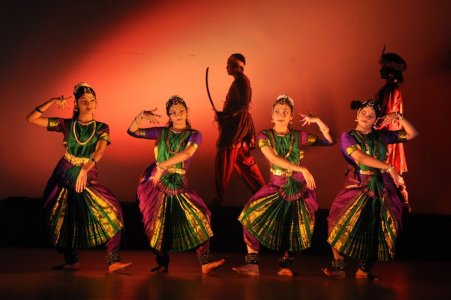 Nritya Taranga The evening programme of day 1 was held at Devaraj Urs Bhavan, Vasantha Nagar. The evening included two programs, a solo Bharatanatyam by Revanta Sarabhai and thematic presentation Nritya Taranga directed by Lalitha Srinivasan. 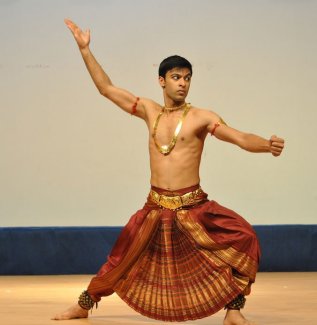 Revanta Sarabhai It was the solo Bharatanatyam performance of Revanta Sarabhai that elicited a mixed response. Revanta is a sprightly dancer with a great amount of energy influenced by his mother – well known dancer Mallika Sarabhai. In the recent past, we have witnessed the merging of boundaries in the ‘banis.’ Most young dancers who learn from multiple gurus have imbibed attributes from the respective styles and all in all bring about a polish, neat lines etc to their amalgamated style. Exposure to viewing dancers like Dhananjayan, Malavika Sarukkai, Rama Vaidyanathan etc from different times have created a lasting impression in the minds of young dancers resulting in their pursuit of making their lines clean and crisp, the movements controlled and compact. Revanta’s nritta lacked these aspects and could do with some work and practice. As far as the compositions were concerned, they definitely need to be appreciated for the exercise of translating English poetry into Tamil and trying to retain the flavour of a traditional varnam composition. The lyrics also were apt and suitable for delineation. “O yen daivame” in Thodi raga set to adi tala saw the dancer express an emotional connect with the lord. Where did I go wrong? I did such severe penance to mirror the tandava like you; I danced till my feet were sore..... This varnam provided ample scope for abhinaya and sanchari bhava which could have elevated the audience to higher levels. Revanta’s sensibilities and exposure to global phenomena have tuned him to performing abhinaya in the “realistic” way rather than the stylised and often seen nuances of abhinaya especially in the south of India. It was the padam that drew very diverse reactions. The hero waits for his girlfriend and experiencing the pangs, he writes emails to her and keeps looking at his mobile for it to ring. He remembers the times he spent with her having a coke. He is angry that she chooses not to remember him and come to him. Finally when he is exasperated, the door bell rings and lo and behold! Here is she is, wow it’s you... animated actions and expressions ensue ending in joy. While traditionalists felt the story, the expressions, the movements, did not conform with the language of Bharatanatyam, “it felt like using/thinking the language of Tamil and speaking in Hindi” said a young male dancer. The modern thinkers felt it was essential to bring today’s lifestyle on to the dance stage and depict the ongoings of the youth’s life. A large part of the dancer crowd felt let down by this performance. Day 2: Morning 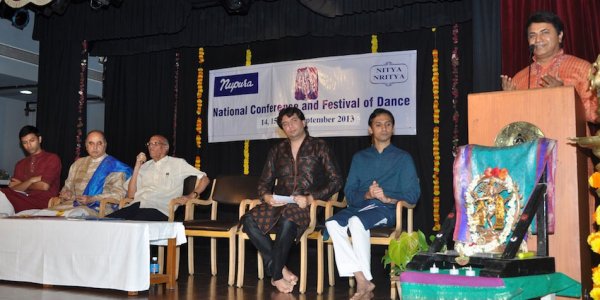 Panel A discussion panel on ‘Male Dancers and their aspirations’ featured keynote address by Prof Nagabhushan Sharma. The speakers were Shridhar, Praveen Kumar, Revanta Sarabhai and Aniruddha Knight. The purpose of my Ph.d: Shridhar mentioned the development of dance art moving on to the fact that Kathakali and Kuchipudi were male oriented and that Bharatanatyam was female oriented especially since the “sadir” times. Most compositions are ‘nayika’ based and it’s very easy for a girl to take to dance whereas for a boy to take to dancing has many challenges, ranging from parental pressures, peer pressures of being called ‘effeminate,’ the stigma attached to boys learning dance, making a profession/living out of it, etc. While many not so good female dancers easily find platforms to perform, it is extremely difficult for a good male dancer to find an opportunity. Opportunities to perform is one of the main challenges felt Shridhar. “Bharatanatyam is a language and not the prerogative of any gender,” says Shridhar. Keeping up the tradition or changing the repertoire: Aniruddha Knight, the grandson of legendary Balasaraswati, shared how he was the first generation male dancer in an extremely female dominated family of artistes. “While Kandappa Sir understood the need for refinement, it does not give me the freedom to change the repertoire. We have to use the language of Bharatanatyam to its eloquent best.” Aniruddha spoke about the quandary of how to tackle shringara by male dancers. Quoting Balamma, he said” Bharatanatyam is suggestion, not literal interpretation. So, how do you depict the role of a forlorn maiden deeply in love and is suffering the pangs of separation? If you do it eloquently it will come out appropriately, she said. Tradition is a reference point not a fashion, that way my parampara has come and gone out of fashion many times.” Tradition is as pertinent as ever! Classical Dance in Modern times: Revanta Sarabhai spoke about the relevance of traditional padams in modern times. He explained the thought behind his mother and him writing English poetry and then translating it into Tamil to present. Use the vocabulary to present contemporary thoughts. While he shared that he supports the traditional repertoire and compositions, his urge to connect with the current time makes him endeavour such compositions. Teaching, performing and conducting dance: Praveen Kumar spoke about how he discovered teaching methods (apart from those that he learnt from his gurus) in his journey as a teacher. Even today he keeps understanding and learning different aspects. As far as compositions for male dancers go, Praveen is of the opinion that we are after all playing a role and so there is nothing wrong in doing nayika bhavas. Why can’t men express? The morning seminar session ended with a summing up by Mysore V Subramanya. He dwelt upon the points spoken by each of the speakers and added a couple of important aspects that they had missed out. What is the reason for dwindling numbers of male dancers? By the time they reach a senior level they come into single digits. Why are we indulging in ‘concert related training’ and not training for perpetuation of art or serious learning? Hard work must be an essential part of training. Male dancers must figure out what kind of costume looks good on them. Aharya is also important and they must take note of that. His closing words were: hard work is important, homework is important, this ‘kartavya’ is imperative. 
Sanjay Shantaram
The performance for the morning was a Kuchipudi recital by Sanjay Shantaram, one of the few Kuchipudi male dancers in Bangalore. He has had training from Veena Murthy Vijay and is currently learning under the ‘Shankarabharanam’ star Manju Bhargavee. Sanjay has now imbibed the Vempati Chinna Satyam bani and this was evident in his adavus and stances throughout the performance. Day 2: evening 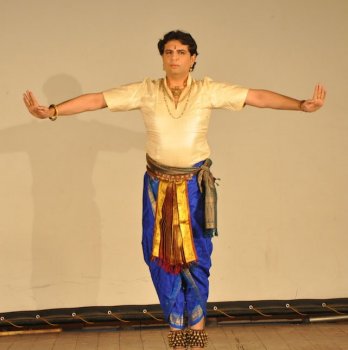 Aniruddha Knight The evening began at the NMRKV Mangala Mantapa, Jayanagar, with the solo recital of Aniruddha Knight. The performance took one back in time to the traditions of yore. The alarippu in tisra eka talam underlined the rendition of the thirupugazhal in Nattukuranji ragam. Speed dominated the performance especially in the varnam “Mohamana.” The entire delineation was in dhruta kala and Aniruddha sped through the jathis. The tradition of singing the lyrics in tandem with the rendition of the jathi patterns was new to many of the dancers in Bangalore. Aniruddha performed all the lyrical descriptions extempore just like his grandmother did in those days. Most of the dancers in those generations because of their ability to sing performed the abhinaya portions extempore. Aniruddha has to work on making his lines and adavus cleaner and tighter to match the current dance scenario. With speed dominating the execution of the varnam, Aniruddha failed to complete the adavus and teermanams to satisfaction. It was the “Krishna nee begane baro” that was a hit with the audiences of Bangalore. The sanchari bhava depicting the Draupadi episode was the highlight of the padam. Aniruddha concluded with a short thillana due to paucity of time. 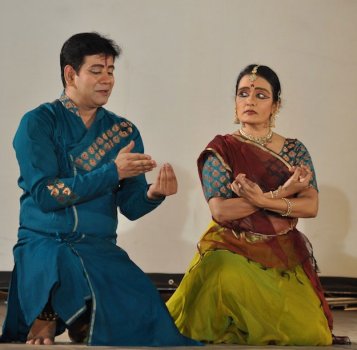 Murali Mohan & Nandini Mehta The popular Nadam group presented a stunning Kathak performance in duet and group presentations. Led by Nandini Mehta and Murali Mohan, the dancers of Nadam danced with vivacity and verve. All the items were extremely aesthetic and eye catching. Day 3: Evening Two Bharatanatyam performances at the ADA Rangamandira by Uma Satyanarayana and Delhi based Geeta Chandran marked the successful conclusion of the Nitya Nritya festival. 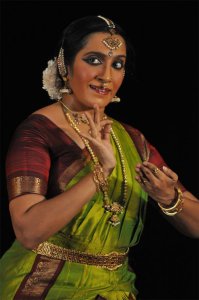 Uma Satyanarayana Uma Satyanarayana, a shishya of Chitra Visweswaran, began with shloka from the Krishna Karnamrutham encapsulating the alarippu with hastas depicting the leelas of Lord Krishna. Interestingly presented, Uma moved on to a pada varnam in Kalyani raga. Dedicated to Lord Krishna, the varnam depicted elaborately some of the awe inspiring leelas while the nayika tells the sakhi, “This is the right time to tell the lord that I am waiting for him, please leave now.” There is no match to his Mohana Rupa. Describing his beauteous features, the nayika brings out how ‘Krishna plays pranks harassing the gopis, but here I am suffering at being separated from him.’ The slipping of the bangles from the wrist of the nayika was beautifully incorporated. Uma is an accomplished dancer and reminded one of her guru Chitra’s performances in the mid 70’s. Uma’s nritta was lyrical, as she moved gracefully across the stage negotiating the pure dance patterns like a gazelle. The scintillating teermanams ended with a gentle yet firm finish. Endowed with a mobile and expressive face, Uma struck a chord with the audiences in her delineation of the popular dasara pada “Jagadodharana.” It was reminiscent of Chitra’s heart wrenching exposition of the same pada. Madhurashtakam blended into a thillana as the concluding piece. 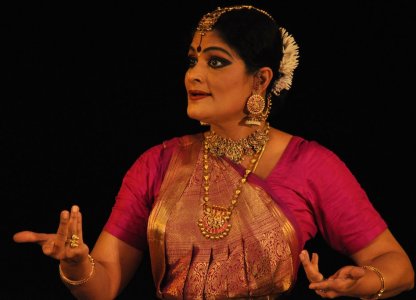 Geeta Chandran Classic approach thrilled the audiences. Geeta Chandran from Delhi began her recital with Chokkanathar Kavutvam describing the lord as the consort of Madurai Meenakshi. The traditional piece with the sollus and arresting poses was a treat to watch. The piece-de-resistance of the evening was the varnam is Suruti raga set to rupaka talam. Again a traditional old composition of Subbarama Dikshitar “Saami yenthani,” the varnam was a delight. The jathis performed by Geeta were intricate and exhaustive, not taking the “intelligent choreography route” where the dancer manages to take quick breaks through poses and walk based adavus. Her abhinaya portions were dignified and emphatic wherever necessary. The ‘neerajakshi’ charanam was performed with precision and attractive hasta expositions. Geeta’s performance concluded with a Meera bhajan in Maand raga popularised by MS Subbulakshmi, “Mane Chakkara rakho ji,” Geeta created a beautiful and spiritual ambience of saint Meera singing to her beloved Krishna. The concluding expressions and lines were soul stirring. The jathi compositions by mridangist Lalgudi Sri Ganesh and nattuvangam by S Shankar as a duo were mind blowing. Shankar got applause for every jathi that he rendered. Vocal by Venkateshwaran was adequate though his pronunciation of the Telugu lyrics in the varnam left much to be desired. Usha RK is a writer and Arts Consultant. |